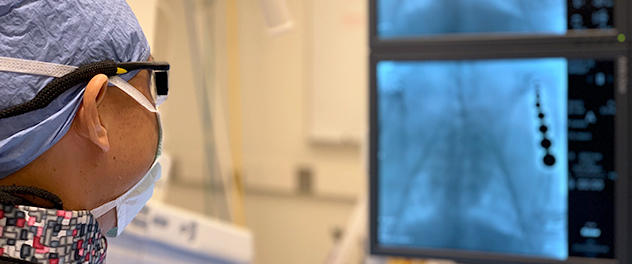 Less-invasive alternatives to brain surgery
Less-invasive alternatives to brain surgery
The Neurovascular Research Laboratory studies intracranial saccular aneurysms and acute ischemic stroke.
Overview
The Neurovascular Research Lab, led by principal investigators David F. Kallmes, M.D.; Waleed Brinjikji, M.D.; Ram Kadirvel, Ph.D.; and Lorenzo Rinaldo, M.D., Ph.D., seeks to understand and identify the mechanisms behind the growth and healing of brain aneurysms. The lab's goals include:
- Improving the management of aneurysms.
- Enhancing imaging techniques.
- Understanding the biological characteristics of clots retrieved from people with acute ischemic stroke.
- Pinpointing the correct treatment for stroke.
Intracranial aneurysms
Open-brain surgery has traditionally been used to treat intracranial aneurysms. But in recent years, endovascular therapies using platinum microcoils have been widely adopted as less-invasive alternatives. While the microcoils can eliminate many of the risks associated with open surgery, they often fail to achieve permanent closure of the aneurysm. This is due to aneurysm growth, as well as lack of collagen synthesis and connective tissues in the aneurysm cavity.
The lab's experimental approach is to better understand the mechanism of aneurysm growth and healing after endovascular treatment. The goal is to develop new innovations for endovascular technology that improve clinical management of cerebral aneurysms.
The multidisciplinary research team applies a variety of molecular biological, histological, tissue engineering and computational flow dynamic techniques. These include imaging the aneurysmal changes and analyzing hemodynamic changes in the aneurysm. Overall, the goal is to better understand how aneurysms heal and identify which treatments are best suited to improve long-term rates of aneurysm occlusion.
The Neurovascular Research Laboratory also is involved in multiple clinical trials of aneurysm treatments. They collaborate with medical device industries as a contract lab for device testing, including good laboratory practice (GLP) preclinical testing services.
Acute ischemic stroke
Achieving complete restoration of the blood supply, termed revascularization, as quickly and safely as possible, is the goal of acute ischemic stroke treatment. The recommended treatment options include mechanical blood clot removal, called thrombectomy, and pharmacologic fibrinolytic therapy, in which medications are used to dissolve clots. However, despite the many advancements in stroke care, only 35% of patients regain functional independence. The blood supply can't be restored for roughly 20% of patients treated for large vessel occlusion.
The Neurovascular Research Laboratory describes imaging and biological properties of the clots retrieved from patients. The lab's team also is making improved tools available for the clinical management of stroke, including an animal model.